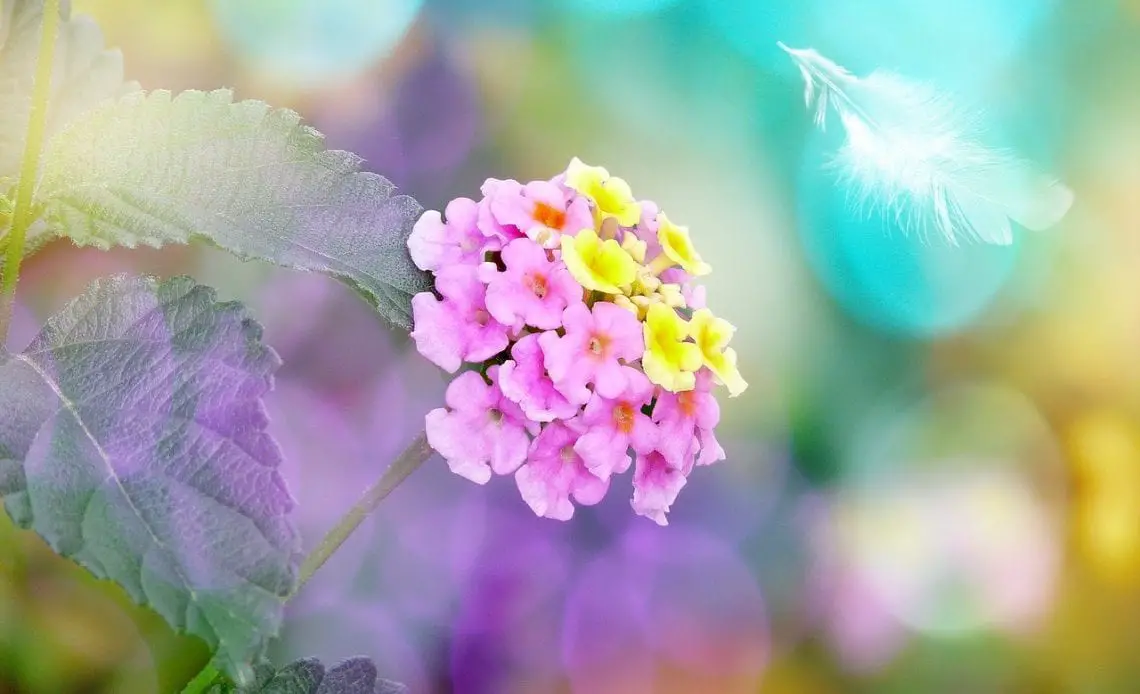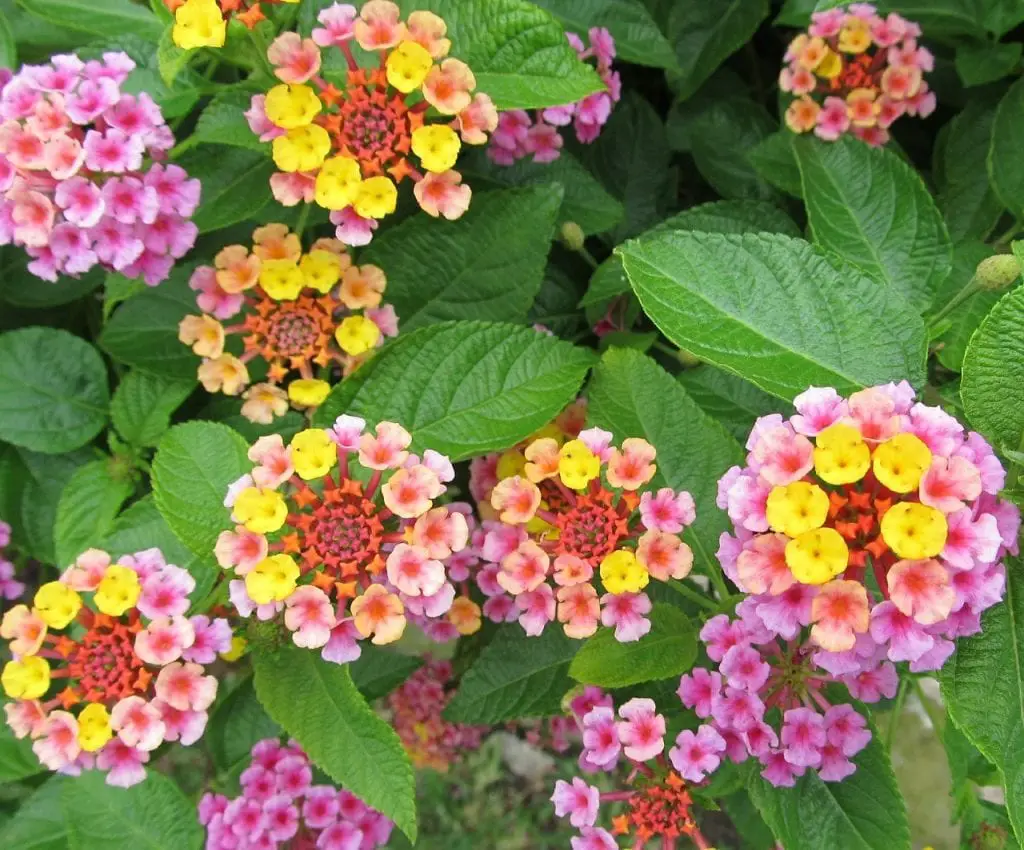
Lantana, pronounced lan-tan-uh originated in tropical parts of America and Africa. Over time, these perennial plants have spread far and wide. They can now be found in the Southern and North-Eastern parts of India, as well as in the Australian Pacific regions. The lantana belongs to a genus of plants that have more than 150 known species. Over the years a lot of cross-breeding between various such species has led to a wide range of multi-colored lantanas.
Lantana plants
The lantana plants are usually herbaceous. But they can also grow to become 6-feet shrubs. The best thing about lantanas is that they bear perennial flowers. If you have a few lantana plants in your garden, you can sit back and enjoy their prettiness throughout the year. Lantana flowers are best suited for tropical climates though. They usually do not survive frost and harsh winters. But come summer, they are again back with a burst of color.
Lantana flowers
Lantanas are like a tiny bouquet of flowers themselves. They bloom in clusters in such an array of colors – red, yellow, white, orange, and even blue. The lantana flowers are small and tubular and grow in thick clusters. Each cluster contains anywhere from 20 to 40 little flowers.

Lantana leaves
Lantana leaves are rough to touch. The underside of the leaf has soft hair-like structures. The leaf edges are serrated and the leaf itself is shaped somewhat like an egg. Lantana leaves are the first sign of the health of the plant. If they look droopy or seem to have lost color, you should check the plant for an aphid attack or powdery mildew.
Types of Lantanas
Lantanas flowers are classified based on multiple factors such as the height of the plant, color of flowers, the shape of the flowers, the structure of the shrub, and so on. Some common types of lantanas are listed here.
Shrub lantana
This shrub grows to a height of up to 6-feet. The plant takes a little care but it is well worth it. The flowers are gorgeous and are produced in vibrant colors such as flaming orange, bright yellow, and pink.
Trailing lantana
This is a low-growing shrub that spreads horizontally. Trailing lantana flowers are mostly purple with a dash of white in the middle. Unlike the shrub lantana, this plant produces only a single color of the flower. It is called trailing lantana because it can be grown along borders or walls with the right support.
Popcorn lantana
This is a unique type of lantana because it is not grown for its flowers. The fruit is the most popular part of the popcorn lantana. These tiny bulbous purple fruits are produced for their ornamental beauty. The plant gets its name because the bunches of fruits look somewhat like popcorn. There are two types of popcorn lantana – lavender popcorn and fruity pebbles. The lavender popcorn berries are of a deep purple color while the fruits pebbles look pink and juicy.
Lantana horrida
As the name suggests, this plant has one horrid aspect. This plant produces a very strong and pungent odor that is not appealing to humans. However, the plant does produce beautiful very vibrant flowers in multiple hues such as red, orange, and yellow.
Lantana involucrata
This plant stands out among all the other brightly colored lantana flowers because it produces pristine white flowers. A cluster of 20-40 tiny white flowers with a delicate spot of yellow at the center is a visual delight. These classy flowers have the added benefit of being mildly fragrant as well.
Pink Dawn Lantana
This lantana is a toned-down version of the otherwise bright lantanas. This low-growing shrub initially sprouts creamy yellow flowers. Slowly these flowers change into a delicate and subtle shade of pink that looks graceful and lovely.
Pot of Gold Lantana
Again, as the name suggests, these bright yellow lantana flowers bloom in a tight bunch that closely resembles a pot of gold. This flower is unique because all the flowers in the bunch have a single color. There is not even a drop of any other color in the center or anywhere else. These flowers can add color and brightness to the dullest of gardens.
Growing Lantanas
Lantanas are non-fussy plants and with a little care in the early stages, they will provide much happiness and color with their healthy profusion of growth.
Lantana vs Verbena
Both lantana and verbena belong to the Verbenaceae family. It is easy to get confused between the two because they are very similar looking. However, they vary in the way they need to be taken care of and also their hardiness. Do make an informed choice about which one you want to plant so that you can take care of the plant accordingly.
Things to keep in mind for growing lantanas
- Lantanas can be grown directly in the soil or in pots in your garden. Trailing lantanas can also be sown in hanging pots.
- You can start with stem cuttings or with seeds, thought stem cuttings work better and faster.
- The best time to plant lantanas is before they start blooming in spring. Make sure that the cold weather has passed.
- Make sure there is a ready water supply to the plant at all times. For potted lantanas, keep the pot in a plate of water so that the plant can draw water as needed.
- Keep in mind that lantanas thrive best in well-drained pots or soil. They do not like a continuous state of wetness.
- Lantanas are partial to sunshine. Plant them in well-draining soil in a sunny location. They need at least 5-6 hours of sunlight. Even when kept indoors, place them facing south so that they get plenty of sunlight.
- Rotate the pot once in a while to prevent the plant from leaning in one direction due to its penchant for sunlight.
Additional tips
- Keep an eye on the leaves. They indicate the overall health of the plant. If they look droopy or lose color, the plant might have some infestation.
- Lantanas are pretty rugged and strong plants. But they are not above an occasional attack by insects or powdery mildew. This can be easily treated with a mild chemical formulation available for plants.
- Though not needed, if you must fertilize lantanas, keep it moderate. Over-fertilization can burn the plant.
Uses of Lantanas
Lantana flowers are such a visual treat that their ornamental value is obvious. That is not the only reason why lantana flowers and plants are popular the world over. Pretty much every part of the plant is useful. Here is a list of reasons why the lantana plant is wildly popular.
- The lantana plants are small and grow close to the ground. The lantana flowers are available in a riot of colors such as yellow, red, orange, white, lilac, blue, and more. This makes them an easy choice as border plants in any garden. They are eye-catchy and will last through most of the year.
- With the right amount of trimming and care, the lantanas can grow more than 6-feet in height. Since they contain such bright bunches of flowers, these taller plants are useful in corners and entryways to create visual appeal.
- The stem of the lantana plant is used to produce pulp for making paper. Toothbrushes are also made from lantana stems.
- Certain tribes in India use the lantana stem to make furniture. This furniture is resistant to termites and rain.
- Lantana leaves have antimicrobial and fungicidal properties. Herbal and home remedies using lantana leaves are used to treat multiple conditions such as skin itches, asthma, and some types of ulcers. Crush the leaves or steep them in water and apply on skin eruptions, cuts, and scrapes to soothe the irritated area.
- Lantana leaf tea is useful for coughs, headaches, and indigestion.
Lantanas Can Get Troublesome
Lantana flowers are a great addition to any garden and provide a pop of color. But they do have a dark side. They are attractive and grow easily. This is their undoing. Lantana flowers attract all manner of pollinators and their seeds get scattered far and wide. This causes them to grow like weeds. Over time, lantanas can take over all available land and overshadow the other plants.
Lantanas are toxic for tiny animals and livestock. When these plants start invading grazing lands, they become a real hazard. One way to avoid this uncontrolled growth of lantana is to cut the bloomed flowers before they start turning into berries. This will help contain their spread.
Lantana Flowers Are Attractive
The adorable lantana in all its varieties has one undeniable draw. The flowers are attractive to birds, butterflies, bees, and humans. Humans use various types of lantana flowers to decorate their houses and gardens. Birds are swayed by their beauty too. Female weaver birds have a special attraction towards nests decorated with lantana flowers. And finally, if you have lantanas in your garden, you can be sure that you will have colorful visitors in the form of a multitude of butterflies.
